#mid 16th century
Explore tagged Tumblr posts
Text

The Mary Rose, by Geoff Hunt (1948-)
109 notes
·
View notes
Photo

Collection of portraits of Saxon princes and princesses with rhymed text ; from 1500 - 1546
#16th century#mdp16th c.#Illustration#early 16th century#German Style#mid 16th century#germany#16th c. germany#mdpillustration
113 notes
·
View notes
Text

submitted by @myryathedreamer 💚💜
#new century for the blog hell yeah!!!! 😎😎#historical fashion poll submission#very historical historical fashion polls#historical fashion polls#fashion poll#historical dress#historical fashion#dress history#fashion history#fashion plate#16th century#1500s#1540s#mid 16th century#mid 1500s
45 notes
·
View notes
Text





✨New From Wulflund✨
Mid 16th Century Gothic Flanged Mace (APW102) is finely styled in gothic fluting and angular styling and its all steel construction is durable.
Eastern European Medieval Flanged Mace (APW100) has a large and robustly crafted head of antique finished high carbon steel which is securely pinned and mounted to a thick hardwood haft.
Corvus Warhammer (ETC01) has all the tools at hand needed to defeat and mangle the heaviest of armors; when wielded by a capable hand it combines the concussive and shattering power of an all steel hammer head with a large armor-puncturing pick.
Thor’s Hammer (APW64) This huge warhammer is a fitting size for Thor himself and a larger than life centerpiece to a collection. This burly weapon fit for a Saga has a head that is crafted from plates of steel which are welded together to keep the inside of the hammer hollow to ensure it is weighty, but not excessively so.
Partisan Head of Frederick Augustus I (APW121) is a replica of the ones used by the court guards of Elector Frederick Augustus I (1694 – 1697) and is a fine example of the late form of the Partisan. It is crafted from high carbon steel and its socket measures approximately 1″ / 26 mm and is intended to attachment to your own haft which is tapered and tailored to fit.
#Kult of Athena#KultOfAthena#Wulflund#Mid 16th Century Gothic Flanged Mace#Eastern European Medieval Flanged Mace#Corvus Warhammer#Thor’s Hammer#Partisan Head of Frederick Augustus I#War hammers#Hammers#Partisan Head#Spears#Pole Arms#SPEARS & SPEARHEADS#Spears & Spearheads#Maces#weapon#weapons#16th century#Viking#Vikings#Mjölnir#Mjolnir#Viking Weapons
10 notes
·
View notes
Note
if you could time travel to any period in the past, just to observe you cant interact with anything, where would you go
ouuugh in the past? probable late 1890s or 1900. also maybe somewhere in 1920-30s but not past that point.
something something is very special to me in how one era of industrial progress and the way of living evolved into another (and very different!) one. and 20th century has its own unique charm for me, so
1 note
·
View note
Text
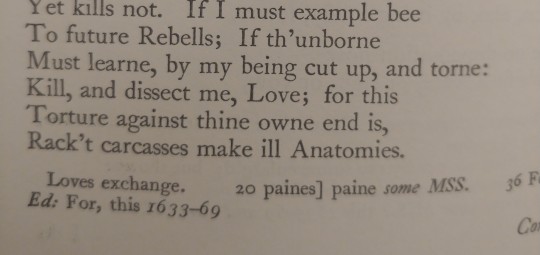
really delightful to realize that like yeah folks have always been fucking unhinged about love.
#john donne in the mid 16th century: KILL ME!!! KILL ME AND DISSECT ME AND PIN MY TWISTED CORPSE UP AS A WARNING!!#me today: god he would have done numbers.#txt
1 note
·
View note
Text

Rapier with gold and silver decorated hilt, blade crafted by Peter Wirsberg of Solingen, Germany. Hilt decorated by Diego de Caias of Milan, Italy. Mid 16th century
from The Dresden National Art Collection
736 notes
·
View notes
Text
15th century (Houppelande the Ritz)

Early 16th century (God please, not the codpiece)

Late 16th/early 17th centuries (That's ruff, buddy)

Mid-17th/early 18th century (If it ain't Baroque, fix it)

Mid-18th century (Big tent party)

Late 18th/early 19th century (Empire state of mind)

Mid-19th century (Hoop springs eternal)

Late 19th-early 20th century (Hustle and bustle)

1910-20s (Ankles aweigh)

#yes the divisions are wonky don't @ me#as for the puns I can only apologize#fashion history#hot takes
1K notes
·
View notes
Note
I LOVE your art!! especially the very specific ways to depict intimacy. It feels very real, it's so so tender but there is often that sheer layer of tension that makes me want to consume as much as your art as possible. I hope I'm not bothering ypu, but what's the porch of your two characters? I love them, I love their dynamic.
Aa thank you for your kind words! I'm glad you like my stuff :>
You probably mean my current main characters, Vasco (the golden floppy-eared dog) and Machete (the pointy white dog). They're a couple living in the late 16th century Italy, at the very end of the Renaissance era. Vasco comes from a wealthy noble background and has a career in politics. Machete is a catholic cardinal, and as a secretary of state he oversees Vatican's foreign politics. Due to their surroundings they have to keep their relationship strictly secret.
Vasco originates in and lives in Florence. Machete is originally from Sicily and lives in Rome. They first met in their late teens/early adulthood when they were both studying in Venice. They were best friends before their feelings deepened, but eventually they had to separate. Machete graduated and was ordained a priest as intended. Vasco dropped out and returned home, where his family pressured him into wedlock. He ended up in a lavender marriage with a lesbian noblewoman named Ludovica (the red and white spaniel), she also has her own partner (still unnamed). Vasco and Ludovica are close friends, they get along well and cover each others' backs, but their union is purely platonic.
Machete and Vasco reunited in their early thirties by random chance, largely because they both work in foreign relations, and quickly resumed where they left off. They don't live together and can only see each other intermittently. Usually it's Vasco who visits Machete in Rome under the guise of working as a Florentine ambassador, but sometimes Machete manages to find an excuse to travel to see Vasco as well. They stay together for over a decade, meeting in secret and maintaining regular correspondence when their duties keep them apart (and quietly come to regard each other as their spouse), until Machete gets assassinated in his early/mid fourties. Vasco lives to his seventies and dies of old age.
They also have a modern au, which works as a sort of a reincarnation situation. They get to be a couple openly, get married eventually and grow old together.
#answered#topsheepstudent#this is such a clunky and inelegant explanation sorry#you can take a look at the#Vaschete lore#tag if you want to read more ramblings about them and their story#they keep sprouting new aus#one being the cowboy au#there's the kid named ear au#and the recent minmax au which follows the canon except this time Machete manages to kill the assassin who was supposed to murder him#and uses his body to fake his death#escaping his doomed by narrative fate and either relocating to Vasco's estate or running away with him
315 notes
·
View notes
Text
Sewing mid-16th century Venetian dress in doll scale - Part 2
I mentioned in the first post that I was meaning to do sleeves for the dress, but lost my patience after failing at it, so I decided to let it go for now. Well, for now has gone and I finally did it after failing couple of more times. I also made a new chemise for the doll (which I also made a free pattern for), since I wasn't happy with the first one and I'm much happier with the second attempt. So without further ado, here's the Venetian Renaissance doll finally finished.
First the new chemise.


Then the new chemise with the dress.


And finally the whole dress!





After all the struggle I'm quite happy how the sleeves turned out!
#historical costuming#historical fashion#renaissance fashion#my art#historical sewing#dolls#my dolls#dress history#dollblr#fashion dolls#doll clothing#custom doll
415 notes
·
View notes
Text

A French Galleon from Guillaume Le Testu's Cosmographie Universelle 1555
42 notes
·
View notes
Text
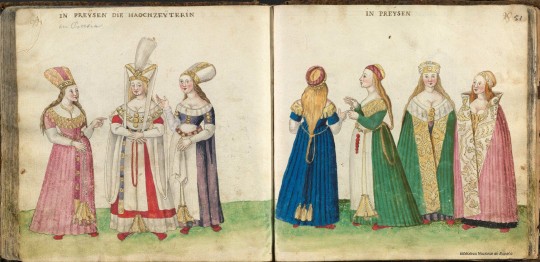
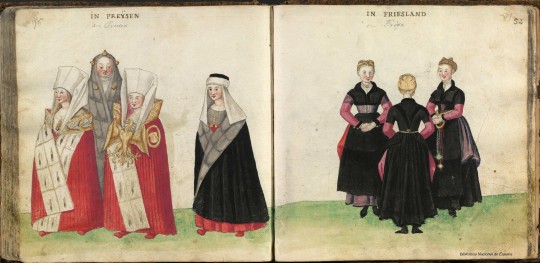
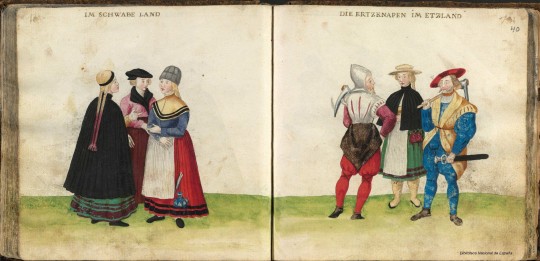
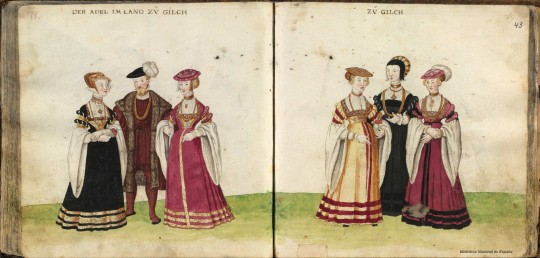
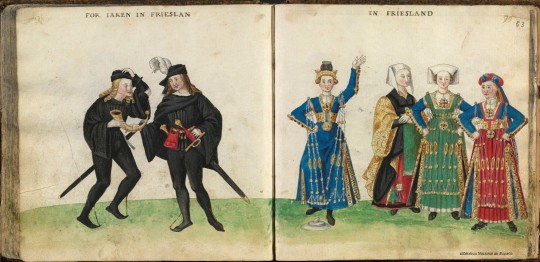
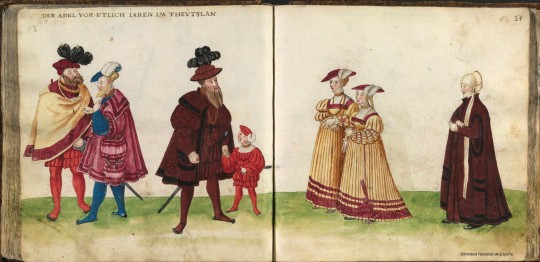
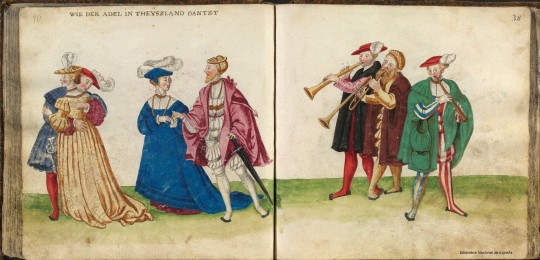
Códice de Trajes, costumes from the realms of Charles V, Holy Roman Emperor and King of Spain, made in Germany in mid 16th century (1540s-1550s)
Prussia
Prussia and Friesland
Schwabia and Elzach
Juelich
Frisia
Germany
German dance
#germany#manuscript#16th century#mdpillustration#illustration#costume illustration#1540s#1550s#holy roman empire#16th c. holy roman empire#prussia#mid 16th century
425 notes
·
View notes
Text



Mid 16th Century Gothic Flanged Mace – Wulflund
This Gothic Flanged Mace is more robustly built than most and it has the heft needed to powerfully smash and batter asunder even the heaviest of armored defense. The mace is finely styled in gothic fluting and angular styling and its all steel construction is durable. Unlike cruder maces, a gothic mace such as this was a finely crafted item intended to deliver destruction from the armored fist of a knight or professional man at arms.
Please Note: Some light pitting or light spotted rust may be present. Most of this cosmetic blemishing can be removed with scuff pads
#Kult of Athena#KultofAthena#New Item Wednesday#Mid 16th Century Gothic Flanged Mace#Wulflund#Mace#Maces#Weapon#Weapons#Flanged Mace#16th century#Battle Ready
1 note
·
View note
Text


Wedding suit (coat, hose and gown of silk) of August von Sachsen, 1548
Clothes from the first half of the 16th century are rare, so having a complete suit is always exciting! This one was worn by August von Sachsen when he married Anna of Denmark in 1548. Originally, the gown ("Rock") was lined with sable and the whole outfit was decorated with golden aglets, which means that it was even more imposing once. The suit is a beautiful example of the preferred silhouette of the mid-16th century: low waist, slender legs and broad chest and shoulders.
Exhibited at the Rüstkammer in Dresden, Germany.
#16th century#historical fashion#renaissance#renaissance fashion#16th century fashion#historical costuming#fashion history#history
170 notes
·
View notes
Text






JULES-LOUIS MACHARD; "ANGELICA ATTACHED TO THE ROCK," 1869
The painting illustrates a moment from the epic poem "Orlando Furioso," featuring Angelica, a princess of extraordinary beauty from Cathay, tied to a rock as an offering to a sea creature. The tale is reminiscent of the myth of Andromeda and Perseus, especially the part where a woman is bound unclothed to a rock in the ocean as an offering to a sea beast, and is saved just in time.
Angelica plays a crucial role in Ludovico Ariosto's epic poem "Orlando Furioso." Orlando, the Christian hero, is among the knights pursuing her. The tale starts with her breaking free from her brother's protective hold and making her way to Charlemagne's court, sparking intense rivalry among the knights vying for her love. As the story progresses, Angelica is kidnapped and tied to a rock to be sacrificed to a sea monster named torc. The knight Ruggiero ultimately saves her by using a magical ring for her protection. Angelica, after experiencing many adventures and romantic relationships, ends up falling in love with Medoro, a wounded soldier, and they elope together. The realization of their marriage sends Orlando into a state of madness.
"Orlando Furioso" gained instant popularity in the mid-16th century, with some Italian critics pointing out that the poem did not follow Aristotle's unity of action, as it contained several plots instead of one main storyline. Some believed that it did not have a coherent structure. The defenders of the poem argued that it was not a classical epic but a romanzo, a genre that Aristotle did not recognize; hence, his criteria was not applicable.
153 notes
·
View notes
Text
Historic Center, San Salvador, El Salvador: The San Salvador historic downtown includes the area where the capital city of El Salvador has been located since the 16th century. This district has long been the country's political, economic and religious center. The history of San Salvador began here in the mid-16th century. Wikipedia
#El Centro Histórico de San Salvador#Centro Histórico de SS#Historic Center#San Salvador Historic Downtown#District 1#San Salvador#El Salvador#Central America#north america#north america continent
183 notes
·
View notes